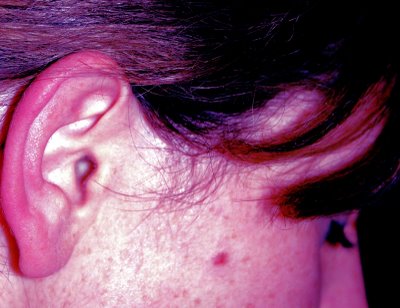
By Laurie Barclay, MD
Medscape Medical News
January 14, 2011 — Red ear syndrome (RES) in children is a highly specific sign for migraine, according to the results of a study reported online December 1 inCephalalgia.
"[W]e were the first to report a possible association between RES and migraine, and more recently other authors hypothesized a crossover between RES and other primary headaches, such as trigeminal autonomic cephalalgias (TACs)," write V. Raieli, from U.O. di Neuropsichiatria Infantile in Italy, and colleagues. "There are still few data, nevertheless, about the frequency of the RES in the general population, its semeiological value or its relationship with primary headaches."
The goals of the study were to determine the frequency, specificity, and sensitivity of RES in a sample of children (aged 4 - 17 years) with migraine and to identify the pathophysiology underlying RES associated with migraine.
Of 226 children with headache enrolled in this study, 172 (76.4%) had migraine, and 54 (23.6%) had other primary headaches. RES occurred in 23.3% of children with migraine vs 3.7% of children with other types of headache (P < .0001). The specificity of RES for migraine was 96.3%, and the positive predictive value was 95.3%.
In children with migraine, RES attacks were bilateral in 65% and lasted less than 1 hour in 35% of children (although duration was not determined in 50%). In 85% of patients who reported RES, this developed during the headache phase. However, most children with RES did not report an association with all migraine attacks.
RES was statistically significantly associated with male sex, throbbing quality of headache pain, vomiting, and phonophobia, based on univariate statistical analysis. In a multivariate stepwise logistic regression model, however, significant associations remained only for throbbing pain, vomiting, and male sex.
"Our study showed that in children, RES is a highly specific sign for migraine," the study authors write. "In addition, the evidence of an association of RES with some migraine features partially provoked by the parasympathetic system supports the hypothesis of a shared pathophysiological background (e.g. via the activation of the trigeminal-autonomic reflex)."
Limitations of this study include retrospective analysis, lack of a systematic analysis of local autonomic symptoms, and lack of generalizability to adult patients with migraine.
"[I]n our opinion, RES is a very useful clinical marker in the pediatric age group, and should be used by physicians to diagnose migraine, together with other migraine features such as vomiting, localization of pain or behavior of the child during the attack," the study authors conclude.
The study authors have disclosed no relevant financial relationships.
Cephalalgia. Published online December 1, 2010.
根據線上發表於12月1日頭痛學(Cephalalgia)雜誌的研究結果,兒童的紅耳症候群(Red ear syndrome,RES)極有可能是偏頭痛的特殊徵兆。
義大利兒童神經精神醫學研究機構的V. Raieli等人寫道,我們首次提出RES與偏頭痛可能有關的報告,最近有其他學者假設RES和其他原發性頭痛,如三叉自律神經頭痛(trigeminal autonomic cephalalgias,TACs)之間有跨界效應。不過,有關一般人的RES發生頻率、其症狀學價值或者其與原發性頭痛之關聯的資料還很少。
這項研究的研究對象是患有偏頭痛的4 – 17歲兒童,目標是確認RES的頻率、特異性和敏感性,並確認RES與偏頭痛之間的病理生理學。
在納入研究的226名孩童中,172人(76.4%)有偏頭痛,54人(23.6%)有其他原發性頭痛;偏頭痛兒童有23.3%發生RES,其他類型頭痛者則有3.7%(P < .0001),RES之於偏頭痛的特殊性為96.3%,陽性預測值為95.3%。
偏頭痛兒童中,雙耳皆發生RES的有65%,35%的孩童持續不到1小時(但是有50%未測定期間)。在報告有發生RES的病患中,85%是發生在頭痛期,不過,多數RES孩童並未提到和每次的偏頭痛發作有關。
根據單一變項統計分析,與RES有統計顯著相關的包括男性、頭部抽痛、嘔吐與聲音恐懼症。不過,在多變項逐步邏輯回歸模型中,只有頭部抽痛、嘔吐和男性幾個變項仍有顯著關聯。
作者們寫道,其研究顯示,對於孩童,RES是偏頭痛的一個高度特定徵兆,此外,RES與某些偏頭痛特徵有關,部分是受到副交感神經系統激發的證據,支持了共通病理生理背景的假設(也就是透過活化三叉神經自主反射)。
研究限制包括:回溯式分析、缺乏局部自主症狀的系統性分析、無法一般化到偏頭痛成人。
研究作者結論表示,就他們的觀點,RES是小兒族群很有用的臨床指標,可由醫師和其他偏頭痛徵兆,如嘔吐、疼痛部位或發作時的行為等,一起用來診斷偏頭痛。






 留言列表
留言列表
 線上藥物查詢
線上藥物查詢 